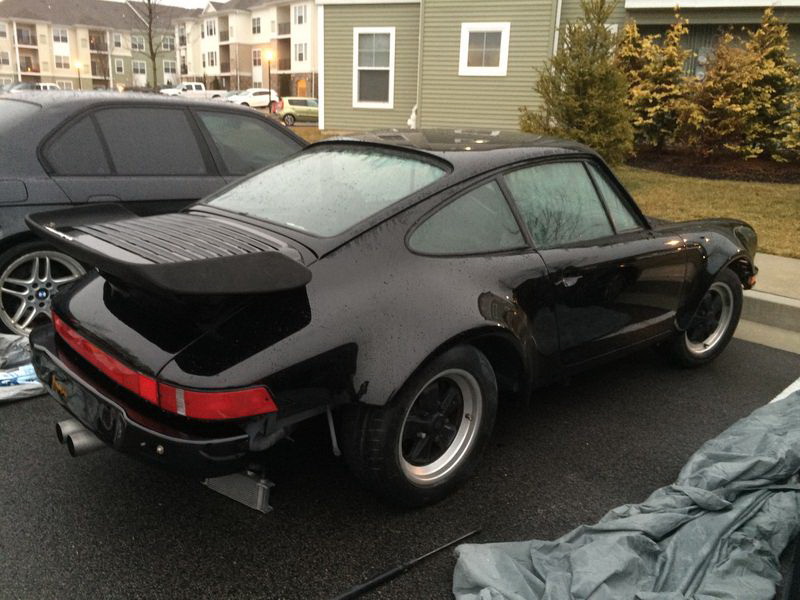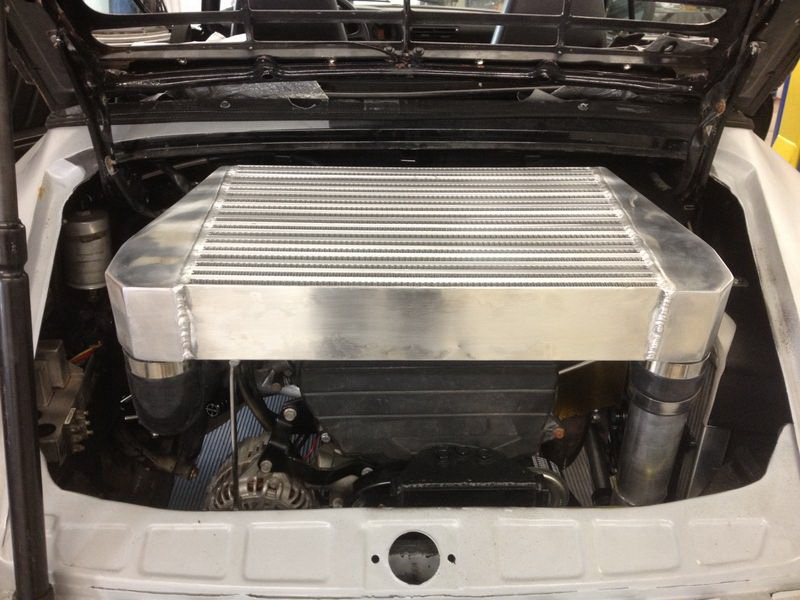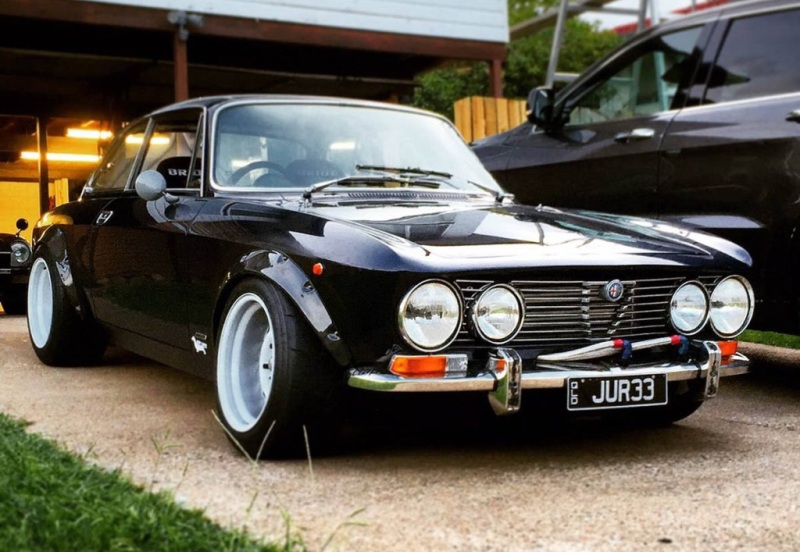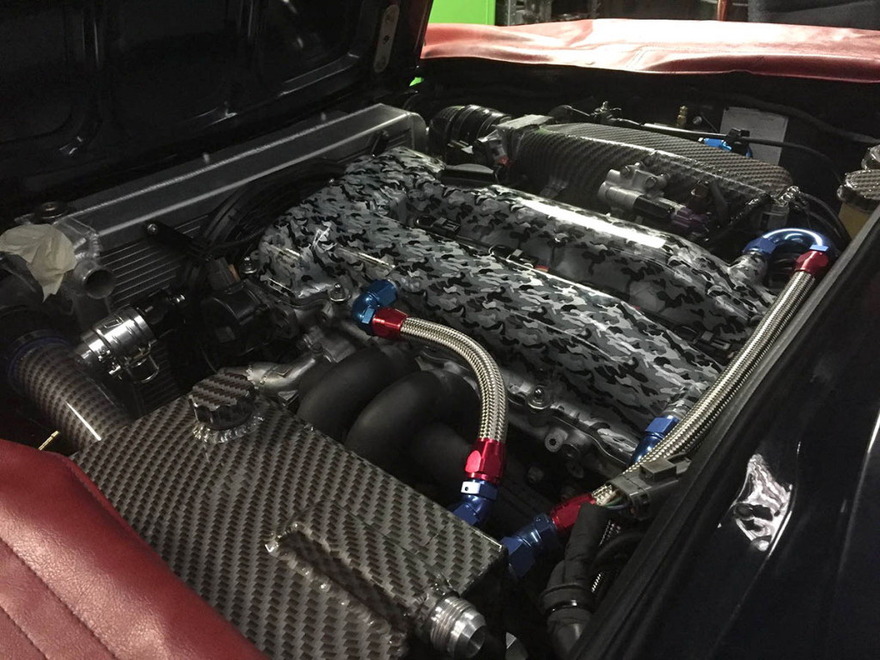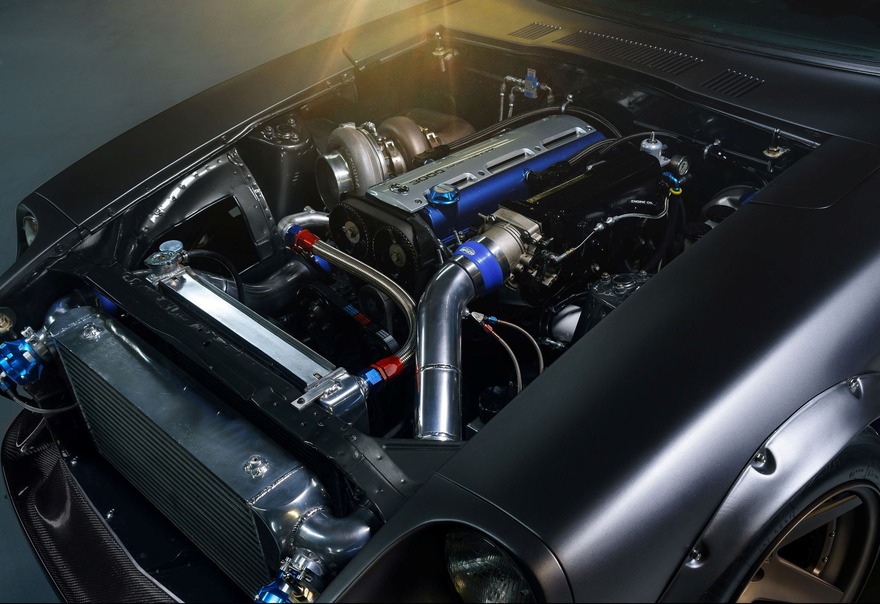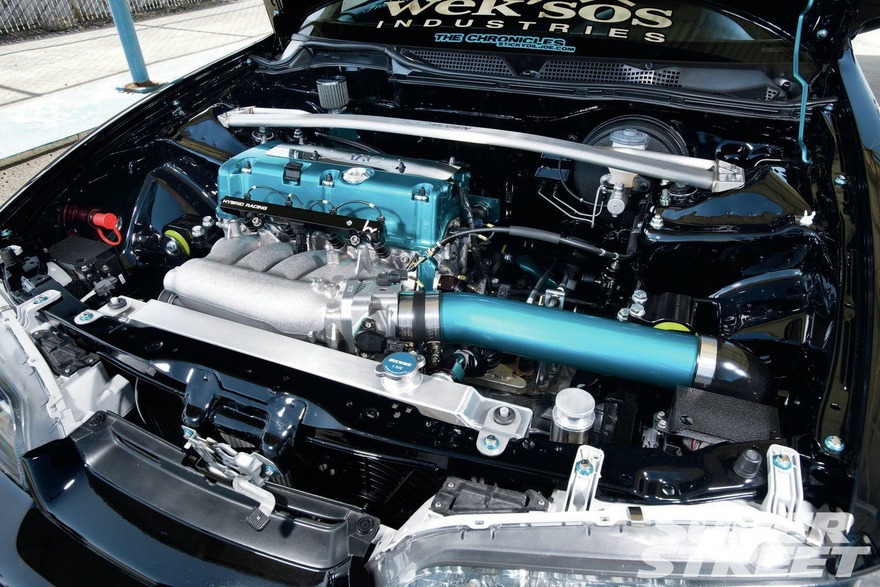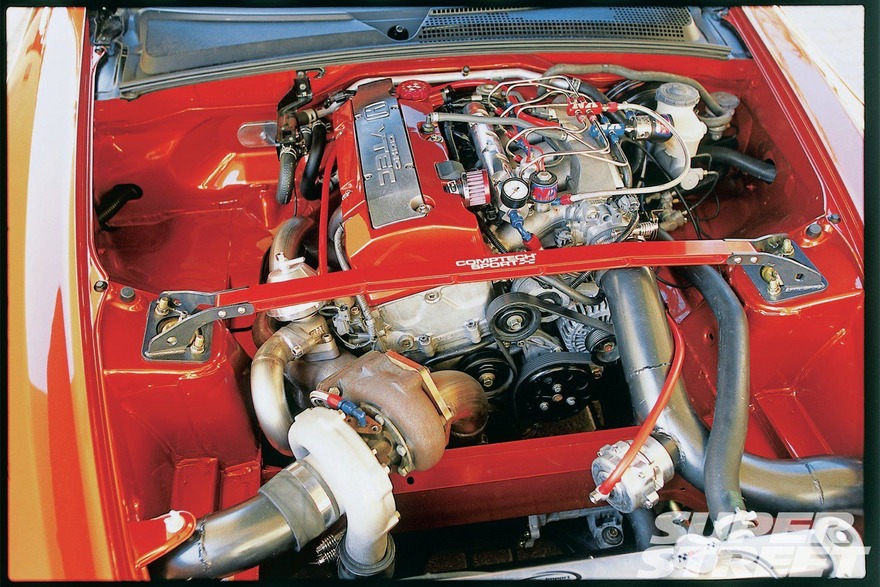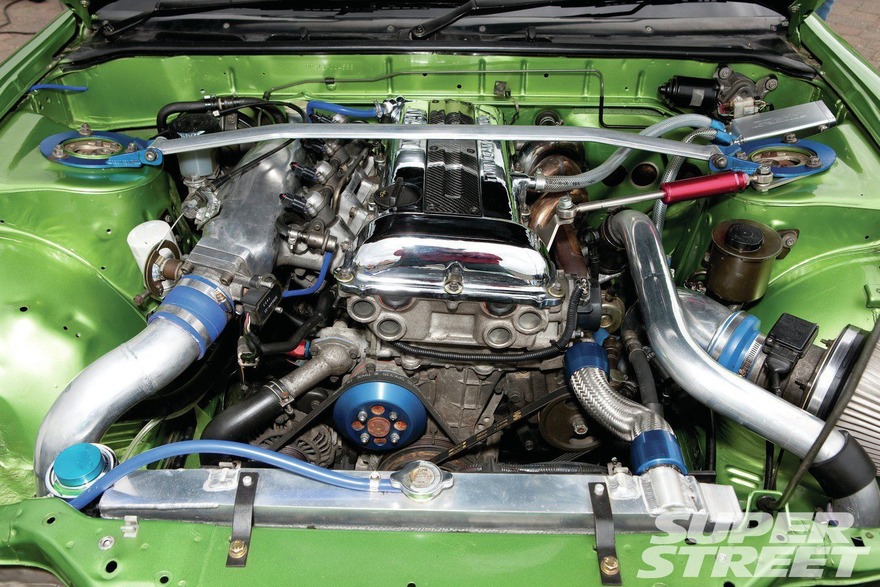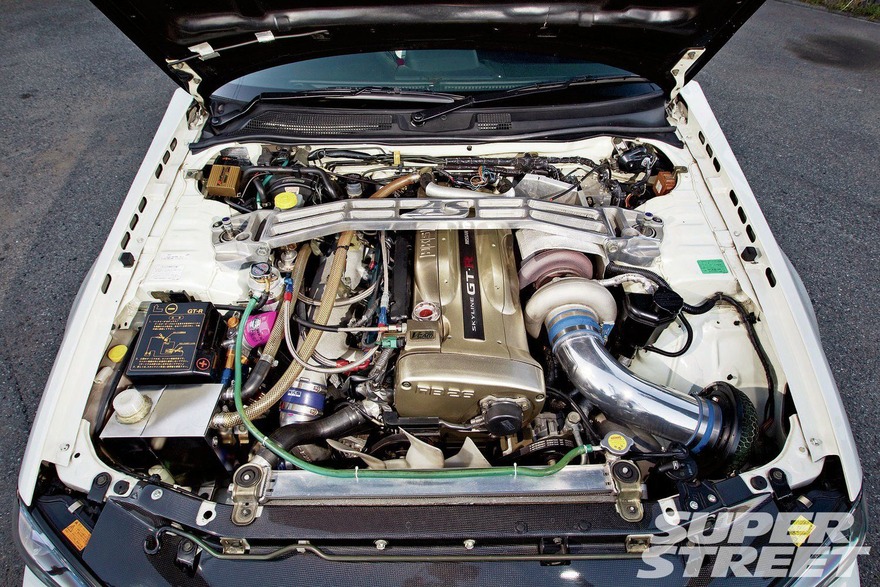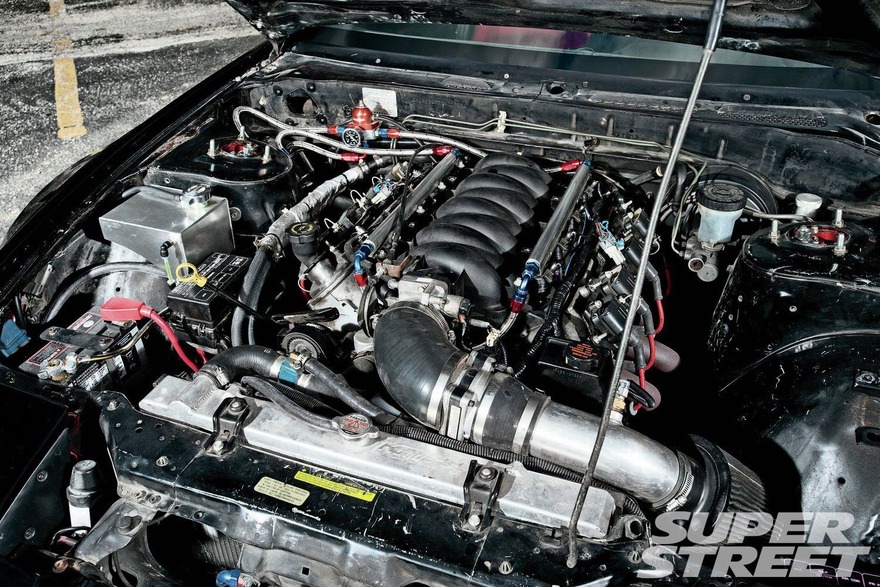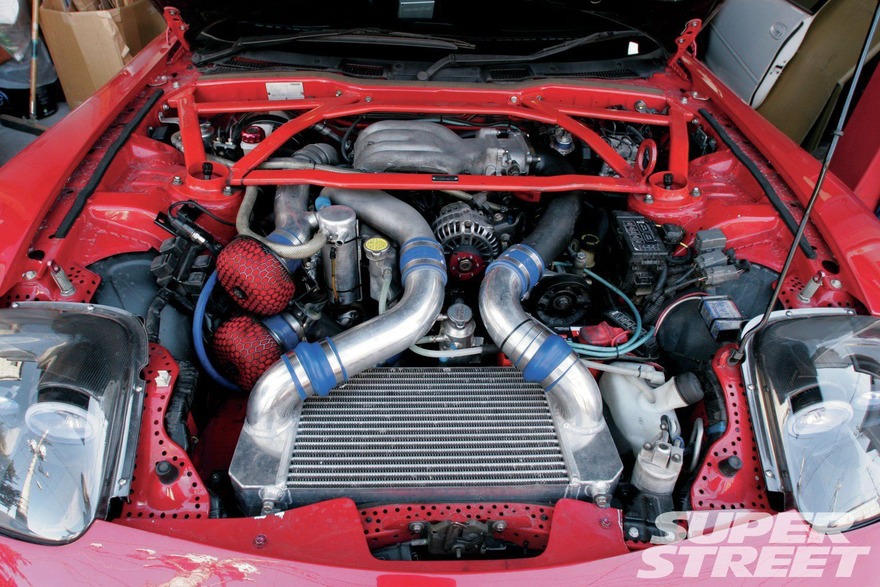The term «Engin swap» (engine swap) today firmly staked out its place in the minds of car fans. It is a very popular in the West, especially in America, as the processing of the car when it «implanted» foreign engine.
To some extent, «Engin swap» — is the simplest and most reliable way to increase the capacity of the car. The level of refinement can seriously different — from a fairly simple substitution with a more powerful engine of the same brand to complex reworking not only the engine compartment, but also the complete replacement of the transmission, up to change the design of the car with front-wheel drive to the rear.
Typically, «Engin swap» exposed though classic, but still cost cars. However, there are also non-trivial variations. For example, the implantation of the modern turbo engine from the «Evolution» to let and not so young, but not the slow 911 Porsche.
Here's another example of crossing the classics with a much more modern and powerful motor — Alfa Romeo 105 engine Nissan SR20.
The attentive reader will already have noticed that in both cases, more than cars of European origin, it is a Japanese engine. And no wonder.
That Japanese engines are most popular for «Engin swaps» and the reason is quite powerful. First, accessibility, namely the relatively low price, and the availability of spare parts. Second, branded Japanese reliability. This is especially important, since it is usually for «Engin swap» is not used the new machines. And third, a considerable margin opportunities in a force, and often not so complicated and expensive by using flashing control unit or installation of the turbine.
Quite respectable edition Super Street Network superstreetonline.com produced its own research, identifying 9 most popular engines for «Engin swaps» — at least in America. Independently there are «hondovskie» units.
1. Honda B-Series VTEC
In turn, among the variety series The most popular are the B16A, B16A2, B16A3, B16B, B17A1, B18C, B18C1 and B18C5. Their popularity is due to the massive and longevity in the market. For example, V16A stands on a huge number, in the Civic 1987–2000. Equipped with the same 1.6 Integra early 90s. Other options a little more rare. So V16V equipped exclusively Japanese Civic late 90s, while B16A2 B16A3 and in the United States were only Civic Si 1999–2000, in. And on the version of «Targa» called del Soto VTEC in 1994–1997, in. As for V17A1, it at all to be found only in the Integra GS-R 1992–1993, in., But more powerful 18S1 was under the hood of this model in the period 1994–2001. 18S5 was available on the Integra Type R 1997–2001, in.
Most often, these engines migrate under the hood of their own sister. This Civic — from old times in 1988 to a much more modern beginning of the 2000s, SRX, the same del Soto, and the Integra. There are cases of installation in more mature Civic (1984–1987, at.) Or Integra late «80s, however, such „Engin swaps“ is much less common.
It should be noted that the B-series VTEC has four different engine architecture. This 1.6-liter B16A, B16A2 and B16A3, similar volume V16V higher unit and a large stroke. 1.7-liter V17A1 almost identical V16A, but also has a larger stroke, whereas B18C, B18C1 B18C5 and have the same size as the V16V but have the greatest stroke of them all. Their capacity varies from 160 liters. with. V16A 200 for some 1.8 litrovikov Type R made for the Japanese market.
The main advantage of «Engin swap» of these engines — cheapness. So for V16A, including actual engine, transmission, electronic control unit, and the presence on the market in excess of fixing kits can cost just a half thousand dollars, at least — in America. However, this can not be said about the «erkah» — V16V can stand in 7500 dollars.
Another huge advantage when choosing the number of Series B is finished «turnkey» installation kits for these «Engin swaps.» They produce Hasport, Innovative Mounts and many others. Despite the fact that they were taken out of production 15 years ago, in a series of not losing their positions, including with the ability to increase capacity. Known even a case of «acceleration» of the engine up to 1200 liters. s., but it was not designed for everyday use. These engines are relatively easy to boost power to 400, however, it will have «comes at a price», as it will require major improvements...
2. Honda K-Series
This is a much more «open» K20A2 engine offered in the USA on the analog Integra — Acura RSX Type S 2002–2004, in. Later, it was renamed K20Z1. With this designation it can also be found on the Civic Si 2006–2011, in. In Japan K20A installed on many models of this brand. In this case, it is best to look for a more powerful version, which for over 10 years, starting in 2001, came with a Civic Type R, as well as «Erki» Integra and the so-called version of the Accord Euro R. In the United States in 2002–2004.. this car was sold as the Acura TSX with a motor larger volume (2.4 liters) — K24A2. In Japan he was known as the 24S, 24T, 24TL, and he was placed on the «osportivlennye» Accord Type S.
As is the case with the series B, often the engine to put on the Civic, CRX del Soto and the years of manufacture from 1988 to much more recent mid-2000s. Often, these motors find their place under the hood, in the Integra 1990–2001., As well as Accord and Prelude mid-90s. According to many experts it is the K-series is almost the standard of the modern 4-cylinder engine. Originally conceived as the «cardinality» — a 2-liter engine in the standard is removed almost 200 liters. s., whereas «erok» capacity exceeds 220 liters. with. True, to pay for everything. This engine is fresh, technological and, most importantly — the most powerful for a given architecture and in standard cubic capacity — hence the price.
«Engin swap» of the «simple» K20A2 cost about 6000 dollars whereas any «Erk» can «tighten» and 10 thousand. In addition to the high cost disadvantages are also possible difficulties with the installation. Nevertheless, the market in the face of mounting kits companies such as Hasport, Innovative Mounts, Hybrid Racing and K-Tuned to deal with it with a vengeance, and under a variety of chassis.
3. Honda F-Series (DOHC)
Already own this engine was placed not on the prosaic car — S2000. 2-liter version F20S «lived» under the hood of her from the beginning of production in 1999 and 2005, after which it was replaced by a 2.2-liter version — F22C. In the US, it is labeled as F20S1, and his replacement as the F22S1. This «Engin swap» is not a simple, yet common. These motors find their place, even under the hood Miata (aka Mazda MX-5). Also, very often they are put on the classic rear-wheel drive Toyota, such as the Corolla, Starlet, and even Celica. Moreover, it was F-series engines «encouraged» some very desperate individuals to convert their Civic (1992–2000 g.) And Integra (1994–2001, at.) In the rear-wheel drive cars!
Unofficially, it is considered the forerunner of twin-shaft F'ki Series K. They debuted Dynamic change of phases in the motor with chain-driven camshafts, and a number of other innovations. It is also generally accepted that the head of the block of the engine is considered to be one of the best for the production of 4-tsilindrovikov. «The standard» both engines (2- and 2.4-liter) developing 240 hp. c., but can still bulkier and show off 220 Nm torque. However, at the same time and it is the main disadvantage — price.
The fact that the S2000 was produced in a much smaller quantities than the ubiquitous Civic (although more than 100,000 also does not figure for rarities), and these engines are much more rare in comparison with the two above mentioned series. This and much more the price of such «Engin swap» — in the best case, the countdown will start from 6–7 thousand. On the side of the F-series is its capacity — to this day, this engine is the most powerful 4-tsilindrovikom ever built Honda. But when it is boosting of decent competition in this sports car like the Ferrari 458 Italia and Porsche 911 GT3 RS 4.0.
Installation of the engine under the hood, even Honda, not to mention the other brands can not be called easy, it will require «samodelschiny», including no small trouble with electronics and auxiliary systems. Moreover, the market hardly offered whale for such «Engin swap», but, as has been said — performance of this engine are worth it.
4. Honda J-Series
This is a relatively new engine, which was released in 1997. It is a family of V-6 tsilindrovikov with the collapse of the cylinder 60 degrees. First of all J-series offers the American market, and in several versions of the working volume. In the US, it has become one of the most popular types of engines for Honda. They are followers of a V6 with the classic archaic collapse blocks of 90 degrees. The new «six» is quite powerful and «Start» with the 240 hp version develops pumping more than 300 «horses». This proprietary system VTEC and i-VTEC were available for all models.
For «Engin swap» option is recommended to take accelerator-driven, rather than touch the gas pedal, which will simplify the installation process. These modern engines are often put under the hood, in the Civic 1988–2000., CRX del Sol, as well as, in the Integra 1994–2001. and even the older Accord mid-90s. However, for the «freshness» of the engine and its capacity to pay. So already the base version will cost about 4 thousand dollars, and when installed will need the appropriate mission, all the electronics and the specific installation with the V-shaped configuration of the engine. The younger and more powerful will be the donor, the more will have to pay for it. However, it is worth it.
It is believed that these engines give the most favorable balance of power output to the money spent during «Engin swap.» The «standard» is simply not find another 250-strong engine for such a cost, however, there are also disadvantages. So not saturated aftermarket installation kit for this series (offer Hasport and Innovative Mounts), and the V'eshka with its almost 250 kg of «live» weight is quite heavy in comparison with any of the 4-tsilindrovikov.
5. Toyota 1JZ / 2JZ
JZ series of engines produced in many guises, but «Angie-swap» popular more powerful turbocharged version. And then the first place is a twin-turbo 2JZ-GTE, which is equipped with the US, in the Supra 1993–1998. and analogous to «Japanese» to which the engine was placed until 2002. In Japan, this row «Six» dual supercharged posed to other models as well as the version of the 1JZ-GTE.
The main advantage of this trehlitrovika is not only common, but powerful engine block, which is considered to be unkillable. It allows significantly increase capacity by double boost. Already in the base engine produces 320 liters. with. and serious torque of 426 Nm. Later derated version 1JZ-GTE (which by changing the stroke of the piston displacement volume has been reduced to 2.5 liters and applied a turbine) has received a firm «toyotovskie» system VVT-i.
Most often, these engines are put to all kinds of Lexus 300-ki, as well as under the hood Supra Mark II and III. Given the same pedigree are «swaps,» are relatively simple, but these often migrate and engines under «alien» hoods in cars such as the RX-7 of the third generation, 240SX or even S2000!
This «Engin swap» is not cheap — for the 3-liter version to shell out at least 7500 yen is not (although it is including turbines and CPR from GETRAG). It takes a serious amount of last budget, and without it, you can invest in 4000. Of course, 1JZ-GTE somewhat cheaper, but do not forget about the necessary electronics to them, as well as mounting kits that will «pull» for a couple of thousand...
However, these engines are such costs as widely recognized, if not considered «nissanovskie» RB, JZ considered the most reliable. And let the installation under the hood of other brands have to tinker, but a number of firms, such as Look to Tech 2 Motorsports, Supra Sport or Zerolift Autolab, not just promote this, and offers complete turnkey packages for «Angie swaps.»
6. Nissan SR20DET
From a family of turbocharged SR for «Engin swap», the most popular is SR20DET. In turn, they come in several versions, differing primarily in the turbine, and the absence of the letter D in the marking would mean one camshaft, instead of the usual two. It is important that the 2-liter 4-tsilindrovik equally suited for front-and rear-wheel drive configuration for the car. This engine was installed on a large number of Nissan over 90 years, including a 180-ki, 200-ki and Silvia. A simple «swap» will be the installation of the engine in the 240SX 90. Quite often they are put on the Miata and even the RX-7 and classic Toyota and Datsun.
Usually they are aggregated with the «native» 6-speed gearbox and top versions are developing a lot for 2 litrovika 230 and even 250 liters. with.
The main advantage of these motors is their budget — only a couple thousand dollars for a full «Engin swap» and a little more if you install on a «foreign» chassis. Another great advantage of this engine — equally suitable for longitudinal and transverse installation, which allows for creativity in the selection of a «victim» under the «Engin swap». Moreover, if not quite difficult handling capacity of the engine is easily increased to 300 liters. with.
Perhaps the only drawback SR20DET is that they are not available now as 15 years. This means that engine to find a decent condition is extremely difficult, and there may be problems with spare parts. For installation in «non-nissanovskie» chassis have to tinker, but McKinney Motorsports enthusiasts offers solution to almost any installation problems.
7. Nissan RB26DETT
Next on the list is another nissanovskiy unit series RB. These in-line 6-tsilindroviki with a working volume of 2 to 3 liters, began to be produced as early as the mid-80s. However, we are talking about one particular engine — 24-valve 2.6-litrovike installed on graceful Skyline GT-R from 1989 to 2002 (R32, 33 and 34). Given their progressiveness and bi-turbo, we have developed the first versions of 280 liters. with. Interestingly, in this case, there are two turbines installed is not consistent, each nourishing its «troika» of cylinders.
This engine is a milestone for the Japanese car industry. In view of the «gentlemen's agreement» Japanese manufacturers, cardinality index remained unchanged, while the latest versions could boast a remarkable torque of about 400 Nm. The realities are not rare variants «overclocked», without any internal modifications to 600 «horses». This contributes to a strong block, and these engines are considered direct competitors of the above «toyotovskogo» 2JZ-GTE.
Their main disadvantage is exclusive to the Japanese market, at least officially. Especially popular are the installation of «sixes» in the iconostasis Z'ki «Datsun», as well as in the Twin Cities 240SX and 300ZX. The price of this engine will be about 3 thousand, but it will have to acquire the proper CPR for rear-wheel drive, which «pull» for at least one thousand, plus so for the mounting kit. The benefit of this will help McKinney Motorsports and Syko Performance. Costs will require more than the usual keeping it in working order, but it's worth it....
8. General Motors LS
The motors of this series deserve a separate article, but we will try briefly. LS Production began in 1997 and lasted 10 years. Then in 2007 they were replaced LS2, which are available today. These motors are among the most common «resin block» V8 and driven such familiar cars like the Camaro, Firebird, Corvette. LS2 and did originally intended exclusively for «Corvette», only later finding its way under the hood of other models of GM. LS6 and LS7 are appropriate «charged» factory versions of both generations that have been developed specifically for the charged version of the Corvette Z06.
As a true symbol of muscle cars, and America as a whole, these V8, as well as their predecessors, find their place in an incredible number of cars around the world. Few people stop that «vsandalit» V8 (typically 5.7 liters) in place inline 4-cylinder «sewing machine», to put it mildly, is not easy. Not to mention the need for appropriate transmission (and in general, not just PPC) and the rest of the...
However, these fans do not stop in front of this «Engin swap» even in front-wheel drive car.
Among the variety of this series it stands out just LS7, who was «broken up» to an impressive 7 liters. Its power in «standard» is 505 liters. with. at a torque of 635 Nm However, taking into account the modified cylinder, hardened steel crankshaft and bearings, titanium pushrods and valve called this engine the drain language does not turn. Respectively, and will spread the cost of this «Engin swap.» «Tired» LS1 can not do just one thousand dollars, while the 7-liter monster «pull» to 15 thousand! And that's not counting all the necessary accompanying «little things» like PPC!
What bribe «Americans» ?! Yes, the fact that only real big V8 that give a real torque which is not replaced by any turbo «mares». Even in the most simple drain LS give newton meters, which can not boast the majority of even charged the Japanese-Europeans.
9. Mazda 13B
Often these «rotorniki» put in a Miata and RX-8, but fans of the Wankel engine and implanted them in other brands. We must not forget that it is 13B-REW was the first in the history of the serial engine, where two turbines (in this case the production of Hitachi) worked consistently. With funny settings, especially in comparison with dzhiemovskimi V8 — 1,3 liters and far less weight and size — twin-turbo rotary from Mazda is already developing in the standard 255 liters. s., and the latest versions and did almost 300 «horses». In addition, these «Engin-swaps» will not be expensive — even the most «screwed» version of the 13B-REW will cost no more than two thousand dollars.
Usually used for such purposes, the transmission of the Eunos Cosmo will cost thousands to the floor. Moreover, these engines are not only allow further «disperse» them. If handled properly, they are reliable and durable. However, still not taking into account a high incidence of «rotornikov» on aftermarket almost no companies specializing at such «Engin swap» and then enthusiast will have to show their ingenuity.
I must say that this list is in reality only a small fraction of the world, «Engin swap.» Today it really is limitless — anything can be found in the garages of those few original power, or just sometimes want to feel like a real car Frankenstein transplanted something of such things under the hood...

